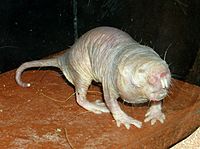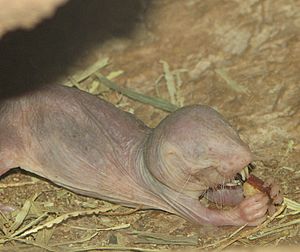Naked mole rat facts for kids
Quick facts for kids Naked mole ratTemporal range: early Pliocene – Recent
|
|
|---|---|
 |
|
| Scientific classification | |
| Kingdom: | |
| Class: | |
| Order: | |
| Family: |
Bathyergidae
|
| Genus: |
Heterocephalus
|
| Binomial name | |
| Heterocephalus glaber |
|
 |
|
| Distribution of the Naked Mole Rat | |
The naked mole rat (Heterocephalus glaber), also called the sand puppy, is a small animal that lives underground. It is a type of rodent, like a mouse or a rat. These amazing creatures live in parts of East Africa.
What makes them really special is that they are one of only two known eusocial mammals. This means they live in a highly organized group, much like ants or bees. They have a queen, workers, and soldiers. The other eusocial mammal is the Damaraland mole rat.
Naked mole rats have some very unusual features. These features help them survive in their tough underground home. For example, they don't feel pain in their skin. They also use very little energy, which helps them live a long time.
Contents
What do Naked Mole Rats Look Like?
Naked mole rats are usually about eight to ten centimeters long. That's about the length of a pen. They weigh around 30 grams, which is like a few pieces of candy.
Their eyes are quite small, and they don't see very well. Their legs are thin and short. But don't let that fool you! They are excellent at moving underground. They can even move backward as fast as they move forward.
They have large teeth that stick out. They use these teeth to dig tunnels. Their lips close behind their teeth. This stops soil from getting into their mouths while they dig. They have very little hair and their skin is wrinkled. It can be pink or yellowish.
These animals are very good at living where there isn't much oxygen. Their lungs are small. Their blood is very good at picking up oxygen. This helps them breathe easily underground. They use very little oxygen compared to other animals their size. If food is scarce, they can slow down their bodies even more. This helps them save energy.
Naked mole rats can't control their body temperature very well on their own. But they have clever ways to stay comfortable. When they are cold, they huddle together with other mole rats. They might also go to warmer, shallow parts of their tunnels. If they get too hot, they go to deeper, cooler parts of their tunnel system.
Where do Naked Mole Rats Live?
Naked mole rats live in dry grasslands in East Africa. You can find them mainly in southern Ethiopia, Kenya, and Somalia.
They live in large groups called colonies. A colony usually has about 75 to 80 mole rats. They build complex tunnel systems in the dry African deserts. These tunnels can be very long, stretching for up to two or three miles in total!
Social Structure and Reproduction
The naked mole rat is one of only two mammal species that are eusocial. This means they live in a highly organized society. In each colony, only one female, called the queen, and one to three males have babies. All the other mole rats are workers.
The workers have different jobs. Some are "tunnellers." They dig and expand the huge network of tunnels. Others are "soldiers." They protect the group from animals that might try to eat them. This social setup is very rare for mammals. It's more like how ants, termites, bees, and wasps live.
The queen and the breeding males often stay together for many years. The other females in the colony don't have babies. This is because the queen's presence stops them from reproducing. But this is only temporary, not a permanent change in their bodies.
Queens can live for a very long time, from 13 to 18 years. They are very protective of their role. If another female starts acting like a queen, the queen can become very aggressive. When a queen dies, another female will take her place. Sometimes, there's a fight to see who becomes the new queen.
Both male and female mole rats can start having babies when they are about one year old. A queen is pregnant for about 70 days. A litter usually has three to twelve babies, called pups. Sometimes, a queen can have as many as 28 pups at once! On average, a litter has 11 pups.
In the wild, naked mole rats usually have one litter a year. In zoos or labs, they can have babies all year round. They can even have a new litter every 80 days. The babies are born blind and weigh about 2 grams. The queen feeds them milk for the first month. After that, other colony members feed them their own feces until they are old enough to eat solid food.
What do Naked Mole Rats Eat?
Naked mole rats mostly eat very large tubers. These are like big underground roots. They find these tubers deep in their tunnels. A single tuber can be 1000 times heavier than a mole rat! They also eat their own feces, which is called coprophagia.
One large tuber can feed a whole colony for a long time, even months or years. They eat the inside of the tuber but leave the outside. This allows the tuber to grow back. Special bacteria in their stomachs help them digest the tough plant fibers.
How Long do Naked Mole Rats Live?
Naked mole rats are famous for living a very long time for a rodent. They can live up to 28 years! This is much longer than other small rodents. Scientists are very interested in why they live so long.
One idea is that they can slow down their bodies during tough times. This might help protect their cells from damage. Scientists have studied their genes to learn more. They found that naked mole rats have special genes that help repair their DNA. This ability to fix their DNA might be a big reason why they live so long.
Who Eats Naked Mole Rats?
Naked mole rats are mostly hunted by snakes. These include the Rufous beaked snake and the Kenyan sand boa. Different types of raptors (birds that hunt) also prey on them. Naked mole rats are most at risk when they are digging new mounds and pushing soil out onto the surface.
Are Naked Mole Rats Endangered?
No, naked mole rats are not threatened. Even though they live in harsh conditions, there are many of them. They are found in large numbers across the dry areas of East Africa.
See also
 In Spanish: Rata topo desnuda para niños
In Spanish: Rata topo desnuda para niños


